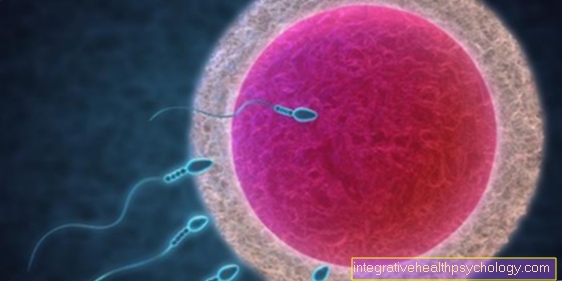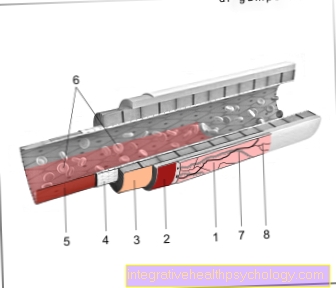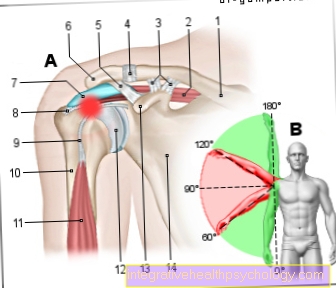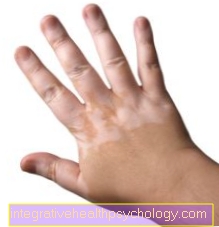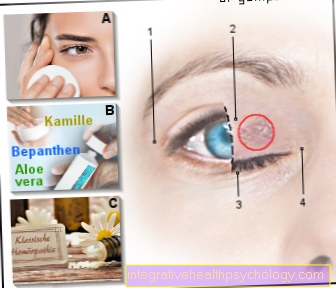Calcification of the coronary vessels
What is coronary artery calcification?
The coronary vessels are the small vessels that run in a wreath around the heart and supply the heart muscle with blood.
If lime is stored in the inner wall of the vessels, it is called calcification of the coronary vessels. As a result, the vessels are hardened and more rigid than healthy vessels.
In technical jargon one speaks of the clinical picture of arteriosclerosis. If the calcification of the coronary vessels leads to a severe narrowing of the vessel diameter, a so-called coronary heart disease (CHD) develops.

causes
The formation of calcified vessels is very complex and is still the subject of intensive research today. High blood pressure values, immune reactions and increased blood lipid values can damage the vessel wall and lead to calcification after a long time.
An unhealthy lifestyle and diet therefore play a decisive role as risk factors.
A high-fat diet and insufficient exercise increase the cholesterol levels in the blood. In particular, the so-called LDL cholesterol, also known colloquially as bad cholesterol, is deposited on the vessel walls. There it is taken up by specific cells and built into the vessel wall. High blood pressure puts the vessel wall under additional pressure at these points and thus intensifies the remodeling processes.
Any diseases or habits that are considered to be vascular damaging can also be considered as further risk factors. These include nicotine consumption, diabetes mellitus and old age.
In principle, men have a higher risk of calcification of the vessels, whereas women are particularly at risk during menopause.
A genetic component also influences your own risk of vascular calcification.
To a certain extent, the calcification of the vessels is normal in old age and cannot be prevented.
- Would you like to find out more about the risk factors for vascular calcification?
Read our in-depth article on the subject: Risk factors for arteriosclerosis
diagnosis
The first point of contact for breast problems is your own family doctor. They can inquire about symptoms, listen to your heart, check blood lipid levels, and do a basic physical exam.
If the family doctor makes the suspected diagnosis of calcified coronary arteries, he will arrange a referral to the cardiologist, the heart specialist. This can display and examine the coronary vessels in what is known as cardiac catheter angiography. This is a special X-ray examination of the heart vessels that can be used to assess them well.
- Find out more about the Diagnosis of coronary artery disease in our in-depth article.
I can tell from these symptoms that the coronary arteries are calcified
The calcification of the coronary vessels is a long-term remodeling process that does not develop acutely. If the LDL cholesterol is built into the blood vessel walls as a result of an unhealthy diet and lifestyle, the affected person does not notice it at first.
Only when this remodeling of the coronary arteries progresses can it become symptomatic.
If there is a strong calcification of the vessels, which restricts the flow through the coronary vessels, one speaks of so-called coronary heart disease (CHD). The heart muscle is then no longer adequately supplied with blood and the nutrients it transports.
Depending on the severity, this manifests itself as pain or tightness in the chest (angina pectoris) or shortness of breath.
The pain is often localized behind the breastbone, but it can also radiate into an arm or even be perceived as upper abdominal pain.
Initially, these complaints only occur with physical exertion or severe psychological stress. However, as the calcification progresses, these can also occur at rest. If the calcification of the coronary arteries leads to a complete occlusion of a vessel, it is called a heart attack. If the calcification of the coronary arteries was previously unnoticed, the heart attack can definitely be the first symptom of CAD
- Do you want to make sure that you do not overlook an existing arteriosclerosis?
You can recognize them by these symptoms: Symptoms of arterioscleosis
treatment
An important part of the therapy is a healthy lifestyle with a balanced diet, enough exercise and sport, weight loss if you are overweight and refraining from any nicotine consumption. If there is diabetes mellitus or high blood pressure, these previous illnesses should be treated and regulated as best as possible by a doctor.
Stress factors should be avoided as far as possible and blood lipid levels should be checked and reduced regularly.
- Find out about the recommended diet for calcified coronary arteries through our article: Diet for heart disease
If the calcification of the coronary arteries is symptomatic as a coronary heart disease, various options are possible:
First, symptoms can be treated with medications such as blood thinners. If the CAD is already well advanced, surgical measures such as inserting a stent or a bypass must be considered.
- For more detailed information on therapy, please also read our detailed article on the subject: Treatment of atherosclerosis
forecast
The prognosis of coronary artery calcification depends on its severity. Slight calcification of the vessels is normal in old age and usually does not cause any problems.
If the calcification of the coronary arteries progresses, coronary artery disease occurs. This disease is the main cause of death in the western industrialized nations and should therefore always be treated by a doctor.
- Is the calcification of the coronary arteries already well advanced? Find out more about the here Coronary artery disease prognosis
Course of disease
The calcification of the coronary arteries is a process that develops over years and does not start overnight. Furthermore, a slight calcium deposit in the vessels is completely normal in old age and usually does not cause any symptoms.
Only severe calcification that exceeds the normal age range must be viewed as a disease and treated as such.
If the calcification of the coronary arteries progresses so far that the blood flow is restricted, the first symptoms often appear.
One then speaks of a coronary heart disease, which may have to be treated.
If the lifestyle is not changed, this disease progresses until there is difficulty in breathing and chest pain in everyday life. Surgical treatment with the help of a stent or bypass must be considered here.
How contagious is that?
The pure calcification of the coronary arteries is not a contagious disease, but a lengthy process that is mainly influenced by one's own diet and lifestyle. Slight calcification of the vessels occurs in everyone with age.
Nevertheless, genetic predispositions also play a role in the remodeling of the vessel walls.
However, if risk factors are inherited, this is not considered to be contagion.
Whether certain infectious diseases can cause calcification via inflammation of the vessel walls has not yet been conclusively clarified. If this is confirmed, an infectious disease as the cause of the calcification of the coronary arteries would be very rare in any case.
Recommendations from our editorial team
- These are the causes of arteriosclerosis
- Atherosclerosis - This is how it is treated
- How can you prevent arteriosclerosis?
- Angina Pectoris - These are the symptoms to help you recognize it






